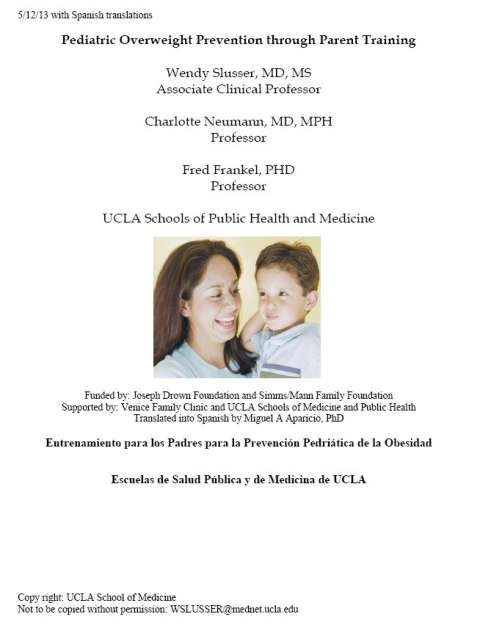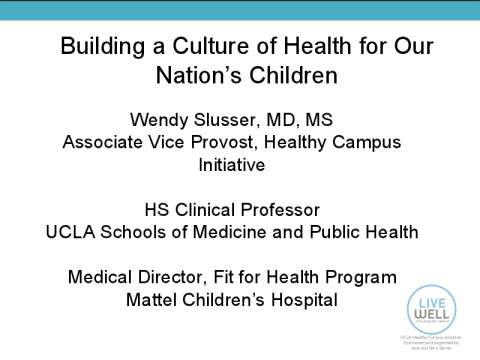Public Health Research
Learn more about our past public health research projects below...
- Fit for Los Angeles
- Evaluation of Reducing Obesity in Childcare Settings in LA County
- Fruit and Vegetable Bar with a Physical Activity Twist
- Fit for Residents
- Increasing Children's Fruit and Vegetable Consumption in Title 1 Elementary Schools: A Pilot Program
- Nutrition Network Evaluation
- Pediatric Overweight Prevention Through Parent Training
- Quality Care Improvement of Nutrition and Physical Activity in Primary Care
- Nutrition Friendly Schools and Communities (NFSC) Development
- LAUSD Salad Bar Program and Evaluation: Research Stimulating Action
- LAUSD Hunger Study: A Cross Section Survey
Fit for Los Angeles

The UniHealth-funded Fit for Los Angeles project aims to reduce the prevalence and the short and long-term consequences of pediatric obesity in Los Angeles and neighboring counties through improving access to high quality Stage 2 (Prevention Plus) and Stage 3 (Comprehensive Multidisciplinary Intervention) services for the morbidly obese child. This will be accomplished by addressing some of the critical barriers to receiving care - lack of provider training and consequent access to high quality and comprehensive services. The proposed Fit for Los Angeles project's professional development and service delivery will allow underserved populations of obese children to receive a high level of expertise and medical sub-specialty care that they otherwise would not be able to access. As a result of the Fit for Los Angeles project, the underserved population of obese children will receive a higher level of expertise and medical sub-specialty care related to their co-morbid conditions than previously has been available to them.
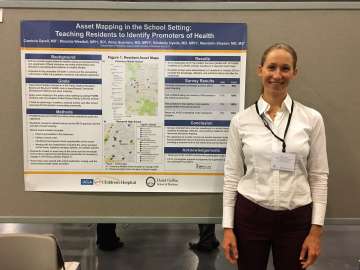
Fit Program Medical Director, Dr. Cambria Garell, presented a poster at the Pediatric Academic Societies and Association for Pediatric Program Directors Conferences outlining outcomes of community asset mapping activities completed at an LAUSD middle and high school by UCLA Pediatric Residents participating in the Public Health Ambulatory Basics and Beyond training track. Title: Asset Mapping in the School Setting: Teaching Residents to Identify Promoters of Health.
Reducing Obesity in Childcare Settings
Funded by the Joseph Drown Foundation, the “Evaluation of the Reducing Obesity in Childcare Settings in Los Angeles County” (LA ROCCS) project aimed to reduce the risk of overweight and obesity in children ages 3-5 years of age participating in childcare services in Los Angeles County. The project evaluated the effectiveness of an evidence-based, low-cost intervention that involved sending a letter home to parents whose children attended a childcare program. The letter informed parents of their child’s weight, height, BMI, interpreted the BMI percentile, communicated basic healthy eating and physical activity recommendations, and recommended the family return to their primary care doctor to confirm the child’s measurements. We found significant BMI improvement at 12 months in children who at baseline had a by BMI z-score ≥ 85% whose parents received a BMI letter.
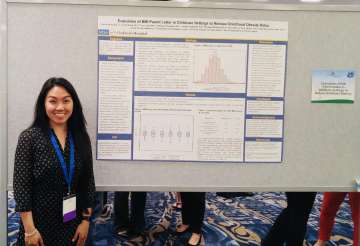
LAROCCS Project Coordinator, Yvonne Nong, presented a poster at the 9th Biennial Childhood Obesity Conference outlining outcomes from our BMI Parent Letter intervention which spanned twenty-six childcare centers across Los Angeles County. Title: Evaluation of BMI Parent Letter in Childcare Settings to Reduce Childhood Obesity Rates
Fruit and Vegetable Bar with a Physical Activity Twist
The Fruit and Vegetable Bar with a physical activity twist project is funded by Anthem Blue Cross. It is a collaboration with the LAUSD Food Services to introduce fruit and vegetable bars in schools throughout the Los Angeles Unified School District. Some of the schools will also introduce enhanced physical activity opportunities for the students.
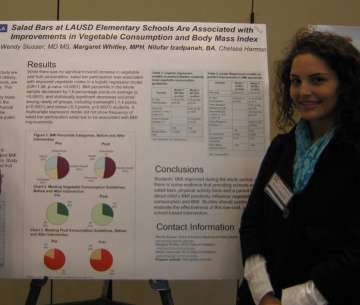
A poster by Dr. Wendy Slusser, Margaret Whitley and Nilufar Izadpanah (shown in photo) demonstrating outcomes from the Fruit and Vegetable Bar project was displayed at the Southern California Public Health Association conference, December 10, 2012. Title: Salad Bars at LAUSD Elementary Schools are Associated with Improvements in Vegetable Consumption and Body Mass Index.
Fit for Residents
The Fit for Residents curriculum was developed by a fifteen physician expert committee who had significant experience in teaching obesity prevention, management and advocacy skills to pediatric and family physician residents, and represented academic and professional institutions from across the US. Representatives from the AAP and AAFP were part of this expert committee. The curriculum had two unique features: (1) the curriculum was written in such a way that it was "adaptable" - it could be tailored to be implemented into specific sites and resources of each pediatric, family practice, medicine/pediatric residency programs; and (2) the curriculum was written with particular attention to issues of culture and socioeconomic issues to provide specific information to physicians-in-training working with racially, ethnically and socio-economically diverse populations. The Fit for Residents curriculum was piloted among five California family physician and pediatric residency programs during the academic year of 2009-10. The pilot study showed how formal pediatric and family physician residency training in obesity prevention and management significantly significantly improves resident's knowledge and clinical practice and contributes to the existing body of research about the effectiveness of curriculum and quality improvement interventions for improving pediatric education and practice. The Fit for Residents curriculum is the first, to our knowledge, to specifically address and evaluate resident training in the prevention and management of pediatric obesity.
Increasing Children's Fruit and Vegetable Consumption in Title 1 Elementary Schools: A Pilot Program
Only 21% of California children ages 9-11 eat five or more servings of fruit and vegetables per day, with daily servings averaging 2.7. Diets high in a variety of fruits and vegetables not only help in weight management but also help reduce the risk of some cancers, cardiovascular diseases, stroke and Type 2 diabetes. This project increased the availability and accessibility to fruits and vegetables during the lunch period of four elementary Title I schools in Los Angeles. 24-hour food recalls, weight and height measurements and knowledge, attitude and behavior questions were asked to more than 600 fourth and fifth graders before and after the introduction of the fruit-and-vegetable bars. The intervention was presented at the NICHQ Conference in March 2008, and findings were published in the Journal of Nutrition Education and Behavior:
Prelip M, Kinsler J, Thai CL, Erausquin JT, Slusser W. Evaluation of a school-based multicomponent nutrition education program to improve young children's fruit and vegetable consumption. J Nutr Educ Behav. 2012 Jul-Aug;44(4):310-8. PMID: 22578965
Quality Care Improvement of Nutrition and Physical Activity in Primary Care
The research team has also been working in a primary-care setting - the Venice Family Clinic (VFC) - to address problems of poor nutrition and physical underactivity in predominantly Latino families living in low-income households. Systems are currently being established to improve overweight pediatric tracking; through advocacy, Dr. Slusser has ensured that VFC patients had affordable access to a high-quality weight-management program. (NICHQ presentation in March, 2008, Slusser, Cameron, Rosales, 2008). Through this work, a clinical tool has been developed that is demonstrating at the largest free clinic in the U.S. to be effective in helping to reverse the trends of overweight.
Pediatric Overweight Prevention Through Parent Training
Dr. Slusser conceived this program with UCLA colleagues to develop an innovative intervention to prevent overweight in Latino children ages 2-4 years old, combining evidence-based prevention programs with evidence-based parent-management skills instruction. The parent-training program involves 1.5-hour classes held once a week for seven weeks, and is designed to integrate nutrition and physical-fitness education. It is taught at the Venice Family Clinic and it has recently expanded to community sites. The intervention was presented at the 0-3 Conference in December 2007. Also, findings of the Parent Training study were published in two academic journals:
Slusser WM, Tolller Erausquin J, Prelip M, Fischer H, Cumberland W, Frankel F and Neumann C. (2012) Nutrition knowledge and behaviours of low-income Latino parents: Associations with nutrition-related parenting practices. Early Child Development and Care, 182 (8): 1041-1055.
Slusser WM, Frankel F, Robison K, Fischer H, Cumberland WG, Neumann C. (2012) Pediatric Overweight Prevention through a Parent Training Program for 2-5 year old Latino Children. Journal of Pediatric Obesity, 8(1):52-59. PMID: 22799481
Parent Training Guide is now available!
You are welcome to use our guide, the only key fact is that you need to adhere to a model of social learning which takes some practice. This model is based on facilitating discussions with the parents who attend about their reporting back on there successes in trying out the action plans we assign from the previous module. These action plans revolve around the parenting skills and the nutrition information that is presented/discussed and role played in the previous module.
Nutrition Network Evaluation
Dr. Slusser and UCLA colleagues have been evaluting the nutrition-network program for LAUSD since its inception in 2001 (Prelip et al, 2006). With a grant from the United States Department of Agriculture (USDA) through the California Department of Health Services, and in-kind district contributions through staff time, the LAUSD established the LAUSD Nutrition Network in October 2000. The Nutrition Network goal is for children to eat the recommended amount of fruits and vegetables, and participate in 60 minutes of physical activity, each day. As a result of this work, LAUSD is focusing more efforts on outreach and education of parents.
Nutrition Friendly Schools and Communities (NFSC) Development
The aim of this study is to develop a comprehensive environmental model to address the health needs of LAUSD elementary school children by improving their nutritional status. The pilot study has demonstrated success in involving school and community stakeholders, including local parks and recreation staff, community health providers, parents and farmer's markets to improve the school environment and support healthy eating and physical activity (Slusser, et al, 2004; Vecchiarelli, et al, 2005). Major outcomes include a tool kit and extension of the work in LAUSD to conduct a worksite wellness study in LAUSD.
LAUSD Salad Bar Program and Evaluation: Research Stimulating Action

In response to the findings of the 1998 Hunger Study, LAUSD placed salad bars in three elementary schools as a pilot program to increase consumption of fruits and vegetables (FV) and combat obesity. Evaluating the results, Dr. Slusser and UCLA colleagues found FV consumption increased from a frequency of three to more than four FV. (Slusser, Neumann, Lange, & Cumberland, 2007). As a result, there are 60 salad bars in LAUSD schools. In addition, Dr. Slusser has worked closely with the Director of LAUSD new construction to ensure that the schools have the design plans to support salad bars as part of the school lunch program. The results of the study have attracted much media attention including feature stories on NPR Morning edition and the Jim Lehrer NewsHour.
LAUSD Hunger Study: A Cross Section Survey
In 1998, Dr. Wendy Slusser and UCLA colleagues undertook a landmark study to establish the prevalence and severity of nutrition problems among low-income elementary-school-age children in the LAUSD. Although the impetus for the study was a report of hunger in school-age children, more than 35% of the sample was found to be at-risk for becoming overweight or overweight according to BMI, with the highest prevalence found in the Latino and African-American children (Slusser, Cumberland, Winham et al, 2005). As a result, the Nutrition Network Project was launched in LAUSD, attracting more than $50 million to the district to promote education about nutrition and physical activity.
